By Jeff W. Zimba
When the terms “Belt-Fed” and “Minute of Angle” actually meet in the same sentence, it is unlikely the firearm being discussed is anything other than the OOW M240-SLR.
There are very few firearms that have the “Wow Factor” of a belt-fed weapon. Whether old or new, mounted on an amazingly complex tripod mechanism or a simple bipod, be it .22 LR or .50 BMG, a belt-fed firearm just grabs the attention and imagination of almost everyone new to the military firearm scene.
While there are several civilian legal machine guns and many available semiautomatic variants owned all over the United States, belt-fed guns are a numerical minority. While those who attend the large, organized shoots can see them firing regularly, most people who spend the majority of their trigger time at local public and private ranges don’t have much contact with belt-fed firearms.
There may be several factors involved, such as the high price of transferable machine guns and even the unusually high price of ammo of late, but semiautomatic versions of belt-fed machine guns are becoming more common. Some companies like Ohio Ordnance Works (OOW) have been making several semiautomatic versions of the Browning designs (1918 BAR, 1919A4, 1919A6, 1917, etc) for many years. Others have marketed semiautomatic M2HB versions and even the popular M60. The HK family of belt guns has been around in various semiautomatic configurations for quite some time as well. Add to that, several different belt-fed conversions and custom belt-fed adaptations to completely different platforms, and the trend is becoming quite obvious. What has been left out of the loop are “the latest and greatest” of the belt-fed guns of the current military hardware. As the civilian legal replacement for the old M60, the Fabrique Nationale M240 General Purpose Machine Gun has been unavailable, that is, until now.

Welcome to the Future
Enter Ohio Ordnance Works, Inc. There are only a few companies in the current civilian Class III industry who have been around in such a continuous capacity as Bob Landies, and Ohio Ordnance Works, Inc. A long-time participant, and an amazingly knowledgeable member of the gun culture, there are not many people who are held in as high regard as Bob. He is an RKI (Reasonably Knowledgeable Individual) in the first degree and a fountain of knowledge with an honest answer to anyone with a question. A leader in many “out of the box” projects even before the term existed; his latest adaptation is a civilian legal, semiautomatic version of the new M240 military General Purpose Machine Gun (GPMG).

When asked to test the OOW M240-SLR (Self Loading Rifle), not only did SAR immediately accept, but it turned into a major priority. There is quite a story to tell about this system and we are pleased to bring it to our readers. Even as testing was wrapping up, exciting new propositions were being floated by government agencies for the M240-SLR and we have exclusive, up-to-the-minute information we have been cleared to share with the readers of SAR.

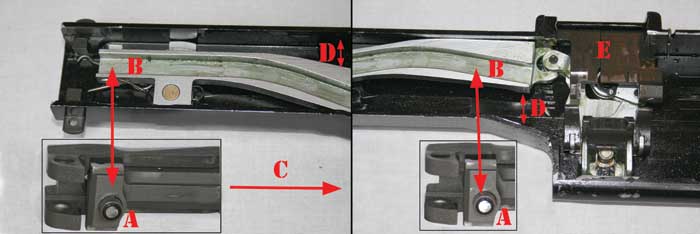
From The Beginning
Some new guns are designed in parallel for fully automatic military applications and semiautomatic civilian marketing. The M240 was NOT one of these guns and to the best of our knowledge it was never intended in this application. Because the only examples were true machine guns with no capability for semiautomatic only fire there needed to be a new receiver manufactured and a new mechanism designed that would meet the BATFE Technology Branch’s definition of not “readily restorable” to full auto fire. It had to have a new, closed-bolt firing mechanism that in no way resembled the original mechanism, nor could it utilize any of the original fully automatic parts. All these goals were met.

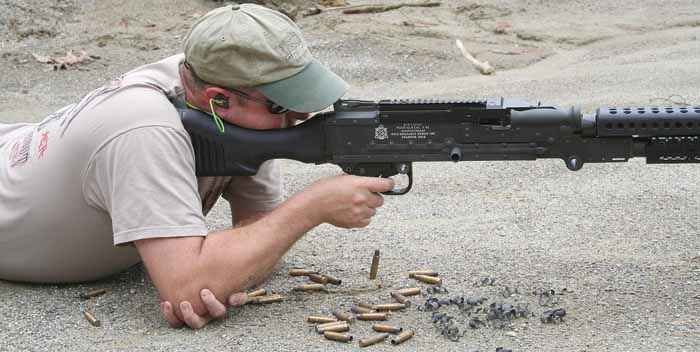
First Impressions
The superb quality of OOW manufactured guns is well known and our expectations were quite high before even seeing their latest offering. Even so, upon arrival it exceeded our expectations. To the casual gun enthusiast it would appear to be a real GPMG with nothing to lead you to believe otherwise. The only indication something may be different than an M240 GPMG was the distinct OOW “Ordnance” logo on the receiver and the letters “SLR” following the model designation.
During the initial examination it was obvious that a great amount of research, development, and workmanship went into this weapon. The fit and finish is excellent and aside from the receiver nomenclature mentioned above, it completely resembles the factory M240 GPMG.
Ready to Roll!
When the test gun was received we were quite surprised at the number of tools and accessories that accompanied it. We were even more impressed to find out that EVERY gun shipped is in the same configuration. All you need is ammo and you are ready to roll. It is even shipped with 2,500 M-13 links.
When you open your new M240-SLR you will find it tucked away safely in its custom fit Pelican case. Also in it will be a sling, cleaning kit, manual, and a massive array of tools including a complete cleaning kit, ruptured case extractor, gas regulator cleaning tool and all the necessary disassembly tools. The number and variety of included tools and accessories was quite remarkable.
Tech Time
The OOW M240-SLR is a 7.62x51mm belt-fed, gas operated, semiautomatic only rifle. It is air-cooled, fires from a proprietary closed bolt mechanism and is fed from standard M-13 links. The M240-SLR utilizes a standard two-step shuttle feed mechanism similar to the M249, the MG42 and the MAG58. The links are a “push-through” design.

The loading sequence of the M240-SLR is as follows: After opening the top cover and clearing the chamber, the feed tray is lowered. Belted ammo is placed on the feed tray against the cartridge stop, open link side down. The top cover is then carefully closed making sure the first round stays in contact with the cartridge stop. The charging handle is pulled all the way to the rear and released, loading a round into the chamber. With a quick disengagement of the safety, located right behind the trigger, The M240-SLR is now ready to fire.
Maintaining the M240-SLR
If this is your first transition to a belt-fed firearm and you are a little apprehensive about the eventual detail cleaning, please let this serve as a testimonial that you have nothing to worry about. Between the enormous number of tools shipped with each rifle and the 31-page instruction manual, you will have no questions when it comes to care, operation or maintainance. Each category is painstakingly illustrated in step-by-step color photographs making every operation a snap. The inclusion of a manual, let alone in such detail, is not that common in a number of available military variants and OOW gets a big “thumbs-up” for this effort. It will be greatly appreciated by the owners.
For Your Eyes Only (Well, Kinda)
Because the operation of some belt-fed systems can be confusing when only explained in words, to help explain how this highly evolved mechanism works, Ohio Ordnance Works was kind enough to provide SAR with a cutaway version to photograph showing every phase of the cycle. The explanation with the accompanying photos can thus be followed and appreciated as the poetry in motion it is. The cutaway makes the once mysterious system as clear as can be.
Range Time
Usually perceived as the most interesting phase of the T&E process, actual shooting time is often the smallest part spent with the system during a testing period aside from endurance or “torture” testing. With a system like the M240-SLR, several hours of reading, studying, watching the parts work together, disassembling, understanding and reassembling are the most exciting phase for a technical article. Tons of work and data collection must come before we get to the range.
On the live fire portions of the M240-SLR testing this writer was accompanied to the range by Michael Harrington, an experienced shooter who has a professional and personal interest in weaponry. It was our own Technical Editor, Dan Shea, who suggested almost 20 years ago the importance of inviting guest shooters for extra “hands-on” with a new system and to approach it from different angles than any one writer will see. Extra eyes and different perceived objectives can certainly make for better testing, and almost always do.
After a sufficient briefing, the targets were set and it was time for some basic function testing. Initial firing proved the system to be extremely comfortable with very little recoil. Since it is a bipod-mounted rifle with a weight of almost 30 pounds it wasn’t unexpected, but the author has had some trigger time on original M240 GPMGs and this system was noticeably less.
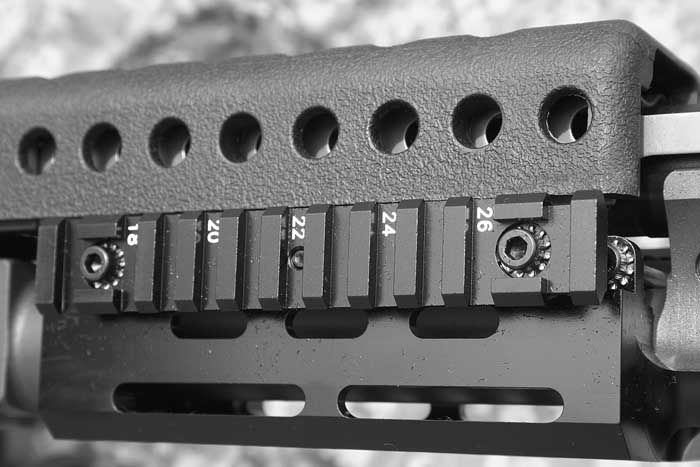
Once it became obvious that the system was working correctly, the sights were adjusted for the range we were on and several rounds were fired at the targets we deployed. Since we were only firing standard LC ball ammo and utilizing the factory graduated ladder sights we didn’t go to the extreme of shooting groups to measure. Once it was quickly sighted in however, every round was delivered to the target with ease. Point of aim and point of impact never wavered.
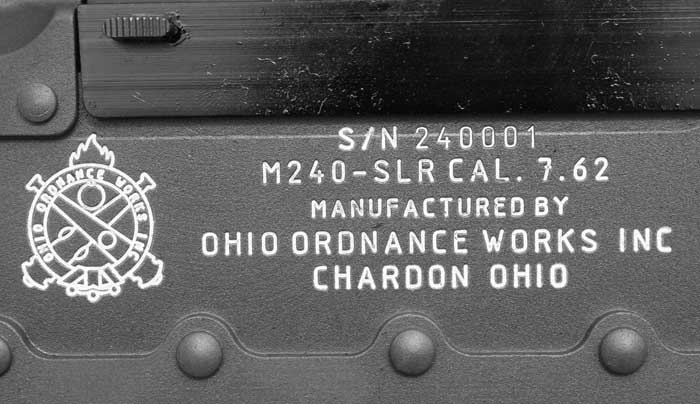
Since we had all kinds of ammo and all the preliminary testing had been done, it was time to simply shoot for endurance to see if we could discover any areas where the M240-SLR needed improvement. We quickly changed the impact area to a spot holding water at the base of a huge sand wall and started emptying belts. With each massive waterspout reaching towards the top of the berm, the M240-SLR continued to chug along in an effortless fashion. Not at all surprising, from the first round fired to the last round loaded, the M240-SLR functioned without failure. No glitches, whatsoever.
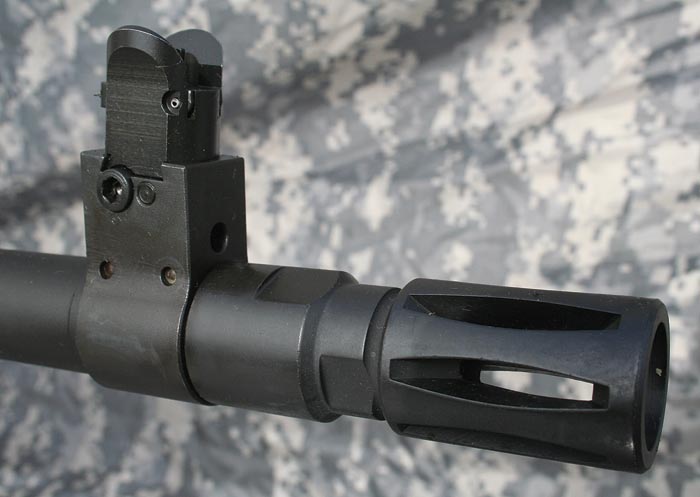
First Blood
Since SAR is a stickler for the truth and full disclosure when testing anything new, there were two incidents with the M240-SLR that must be reported. Although these are both due to “operator error” we thought they were important enough to bring up to save some other end users some potential embarrassment.
The extraction cycle of the M240-SLR is rather brisk, to put it lightly. In plain English, it hammers empty casings out like nobody’s business. That is a positive effect for function purposes but not so good for shooters who forget to pay attention to the bottom ejection path and shoot it from a shooting bench.
The first incident happened when the author forgot to brief the assistant shooter about the ejection path and the rifle was setup on a bench. After a few rounds were fired, a slight arm shake from the shooter gave the author an indication that something may be wrong. A mild shooting position adjustment was made and the remainder of the belt was fired without hesitation. When the gun was cleared a small trickle of blood was noticed on the arm of the shooter and it was quickly brushed off as “a scratch” that was caused by contact with an ejecting case. We knew it could have been avoided by a better briefing before shooting and the author decided to take the blame.
It was the author’s turn to fire, this time to check the point of aim at our current location. Completely disregarding the conversation only moments before, this writer sat behind the M240-SLR and slowly fired a few rounds at the fresh target. After a few rounds were confirmed on target, the author decided that rapid fire testing was be in order to see how much impact shift occurred under those conditions. That’s when IT happened. After firing about 10 rounds a spent case impacted a delicate area of the author’s anatomy. Thinking it was only appropriate to push through the pain and shoot on; the author didn’t skip a beat. That’s when IT happened again. A second round impacted the exact same delicate area and an executive decision was made to immediately cease-fire. It was at that time remembered that there was no need to continue to push through any kind of pain, as no one was shooting back on this sunny day at a local range, and the author was free to double over and wail like a wounded cat. Unfortunately for this writer, Mike the shooting assistant thought it wise to continue shooting photos at a high rate of speed documenting the entire event.
The short summary is simply a warning to NOT place any body parts under the receiver, as this is the path of ejection. Of course, most people shooting these already know that, just like we did. We hope this little laugh at the expense of no more than a little pride will serve as a reminder and save the end user a little humility.
New Horizons and a SAR Exclusive!
When talking to Bob Landies about the impressive and unexpected grouping under the conditions we were firing, he decided to share some exciting new news with the readers of SAR. An unidentified government agency had just contacted him about a potential future purchase. It seems that some parallel testing has been taking place with match ammo, and the M240-SLR has the ability to shoot 1 minute of angle. When combined with the capability for remote firing and an enormous ammo capacity due to the belt-feed mechanism, it has received the attention of at least one government institution with a necessity for just such a system. Since .Gov sales were the last thing from Landies’ marketing plan, this was received with open arms. We were assured that as things develop and we are cleared to share more information with our readers, we would get the nod.
Conclusion
It is a rare opportunity to have the ability to own such a close copy of a current General Purpose Machine Gun. Though the suggested retail price of $13,500 is not on par with a hunting rifle at the local Big Box Store, it certainly is several times less than the $150,000+ a rare, transferable M240 machine gun will cost you if you can locate one and will be considerably gentler on the wallet. If you are a collector or military arms enthusiast looking to fill a void in your collection, this may be the chance to fill a vacancy you may have thought would remain empty. If you have a professional necessity to own an extremely accurate rifle with an infinite magazine capacity you may have just found your solution. If you live in a State where Class III firearms are restricted but semiautomatic firearms are permissible (like Hawaii), this may be an alternative to own something as exotic and current as what you see on the evening news. Maybe you are a soldier who has returned from duty and would just like to have an example of the weapon you proudly carried in service without wanting a second mortgage. Whatever your reason or interest, this writer believes you will be quite satisfied with your purchase. Best of all, the OOW M240-SLR is available for immediate purchase and delivery. If you send a check or make a call, you can bring home a piece of history today. Neither Ohio Ordnance Works nor the M240-SLR will disappoint.
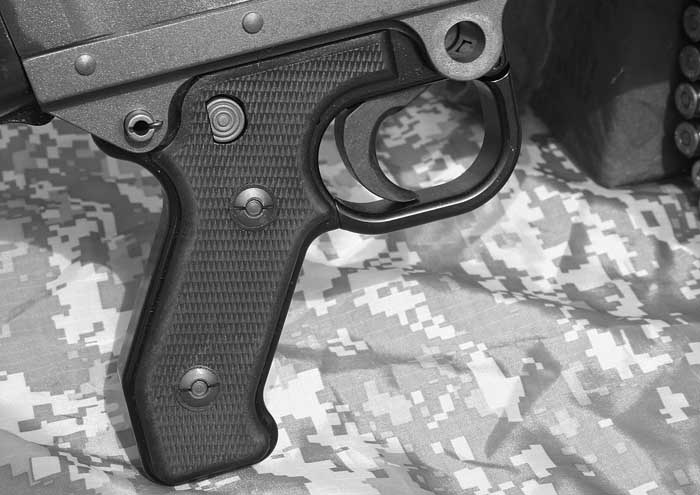
Trickle-Down Weaponomics
There are a few historical dates that need no explanation when mentioned. Two that immediately come to mind are September 11th and December 7th. Even citizens who are not students of history understand the significance of those tragic days. In our specific community, those with an interest in Class III Firearms, there is one other day of infamy familiar to all. That date is May 19th. This tragic date in 1986 represents “The Day the Music Died” for many of those who design, invent, collect, deal in, and utilize machine guns in any fashion.
Except for a very few instances, May 19th is the day new technology ceased to evolve in the Class III Community for the individual collector. In most cases time has been standing still for civilian end users. In the 22 years following this ridiculous ban on the manufacture of machine guns for individual ownership, we have seen the prices of those guns manufactured and registered prior to this date rise several-fold.
As those inside the industry licensed as NFA Firearm Manufacturers, and foreign entities continue to design new weapon systems and improve upon existing systems, civilian end-users in the United States are usually left out. Since most new designs are geared toward restricted military sale and end-use, there is little that enthusiasts can do other than watch from the outside. Unless an act of congress changes the 1986 law, new machine guns will remain prohibited for most citizens to own.
Fortunately for all of us, the technology developed and refined by new military firearm designs can often find its way to the civilian community through other, less traveled avenues. Just like the space program has increased the quality of life for many of us through new technology, and computers have gone from mostly useless, large and cumbersome to compact, affordable and life changing, civilian firearms are also following suit.
There are several new firearms the civilian gun owner will never own under the current laws but thanks to the insight of many people in the military firearms industry, civilian legal, semiautomatic variants are no longer uncommon. Almost every upgrade for the M16/M4 system is available in a semiautomatic counterpart for individual ownership. The “space age” FN P90 SMG has spawned the wildly popular PS90 carbine, and even the remarkable new KRISS SUPER V has a semiautomatic carbine version. The specific subject of this article is an even more brilliant adaptation as the original manufacturer of the M240 GPMG is not the party responsible for bringing it to the non-military market, but from that original workhorse, came this new design, now available for civilian ownership.
Maybe in the future we can get a Congress and an Executive Administration that understands the absurdity of the current laws as followed since 1986. At that point the citizens of this fine country can be back on par with the other end users of the most current designs. Until then, thanks to the foresight of the military gun designers making parallel civilian versions, and those like Ohio Ordnance Works, Inc. designing completely new mechanisms for current firearms, we can at least continue to enjoy the phenomenon I like to refer to as “Trickle-Down Weaponomics” and keep up as much as current law will allow.
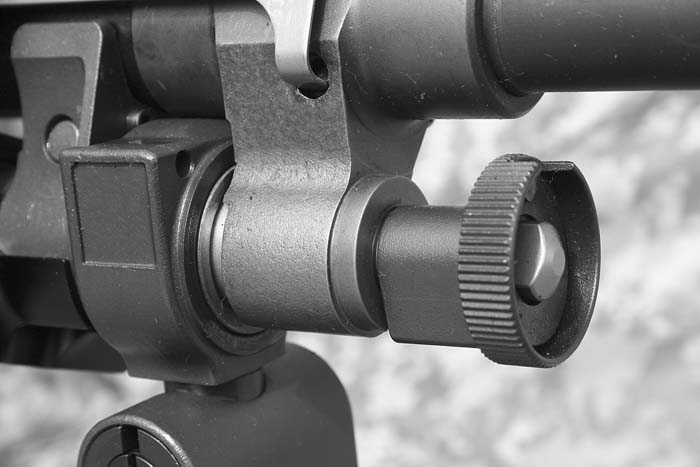
M240-SLR Technical Specifications
Caliber: .308 (7.62×51 NATO)
Weight: 27.5 pounds (12.47 kg)
Overall Length: 48.25 inches (122.56 cm)
Barrel Weight: 7 pounds (3.18 kg)
Barrel Length: 23.75 inches (60.33cm)
Trigger Pull: 5-9 pounds (22.27 to 4.08 kg
) Maximum Range: 3,725 meters
Max. Effective Range: 800 meters
Ohio Ordnance Works, Inc.
310 Park Drive
P.O. Box 687
Chardon, OH 44024
Ph: (440) 285-3481
Fax: (440) 286-8571
www.ohioordnanceworks.com
| This article first appeared in Small Arms Review V12N5 (February 2009) |










